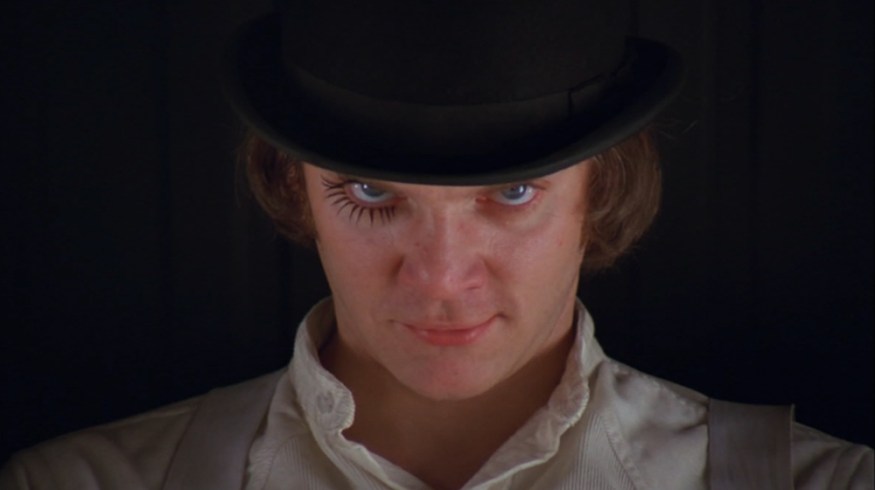
Hook Your Audience With the First Shot
Your film or video project’s first shot is incredibly important. Whether you’re establishing a time and place or unveiling a mystery, a compelling first frame is vital.
Top image: A Clockwork Orange via Warner Bros.
It’s vital that you make your video or film’s first frame as enticing as possible. Doing so will set the tone and allow you to immediately begin telling your story. A unique beginning will stick with your audience long after they finish watching your work.
Let’s take a look at some examples of interesting first shots, explore why they’re interesting, and learn how you can apply the same techniques to your next video or film.
Shot Composition
 Image via The Cinema Guild
Image via The Cinema Guild
If you decide to use a wide or medium shot that exposes your characters’ bodies, the background, positioning and lighting must be figured out prior to shooting.
Take the image above for example, from Lisandro Alonso’s Jauja. The two characters are positioned and angled in such a meticulous way that the shot resembles a painting. This particular shot sets up what follows, which is a series of static, long, drawn-out scenes that echo this first shot.
 Image via Warner Bros.
Image via Warner Bros.
The first shot from Interstellar, seen above, demonstrates an undeniable sense of mystery. Proposing a question to your viewers from the get-go is is a sure-fire way to hook them. Why is there a bookcase? Why is everything covered in dust? Where’s the blackhole I was promised?
In a movie filled with twists, turns, and thrills, the audience immediately expects explanations to follow in the impending hours. Presenting strange questions right off the bat can yield a fantastic payoff in the end.
Establishing Location
 Image via Paramount Vantage
Image via Paramount Vantage
Establishing the location and environment of your video in the opening shot is informative and classically effective. This type of shot (like the one above from There Will Be Blood) tells the audience the “where” of your video (and sometimes, as seen below, the “when”) and often gives them an idea of the mood.
If you captured several establishing shots and B-roll that you’re unsure of what to do with, throwing one of those at the opening is an excellent introductory statement. News packages, corporate videos, and sitcoms all make use the of the establishing shot to open the video.
 Image via 20th Century Fox
Image via 20th Century Fox
In The Terminator (seen above), James Cameron gives us a familiar location, but then throws in some out-of-nowhere details that hook the audience.
 Image via USA
Image via USA
A perfect example of combining these tactics — mystery and location— was seen in the popular USA series, Mr. Robot. The above silhouette shot with the city in the background gives us information on where the show will be taking place. It also presents a couple of questions: Who are these people? And what are they doing?
Introduce Characters
 Image via CBS Films
Image via CBS Films
An immediate portrait shot of your main subject is the perfect way to jump right into a story. This can save a lot of unnecessary expositional dialogue that might give off an amateurish vibe. Inside Llewyn Davis (above) presents the titular character right from the start, immediately throwing the audience into his psyche as he begins his opening “monologue.”
Another classic example of this can be seen in the opening of A Clockwork Orange (see top image), which presents an intimidating, unavoidable shot of Alex DeLarge. Not only can this method save pointless dialogue, it can also express the character’s intent within the first few seconds of the narrative.
Alternative Methods
 Image via Annapurna Pictures
Image via Annapurna Pictures
Your opening frame doesn’t necessarily have to feature an action or characters. It can be an object, part of the body, or purely obscure. The image above (from The Master) is shown throughout the course of the movie as a theme, reflecting the main character’s stream of consciousness. The instant recognition takes the audience back to the beginning of the film and instills the intended feelings.
You’ve probably seen Jacob T. Swinney’s excellent side-by-side videos comparing the first and last frames of popular movies. If you’re planning to come full circle or connect your story in a similar way, these entrancing videos can give you an idea of just why the first frame is so important.
Finding a new, unseen way to kick off your movie or project should be the goal every time. What are some of your favorite opening shots in movies or TV shows? Let us know in the comments below




